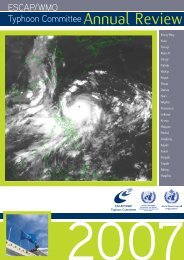TCAR - Typhoon Committee
TCAR - Typhoon Committee
TCAR - Typhoon Committee
Create successful ePaper yourself
Turn your PDF publications into a flip-book with our unique Google optimized e-Paper software.
270<br />
ESCAP/WMO<br />
<strong>Typhoon</strong> <strong>Committee</strong> Annual Review 2009<br />
Frequency of<br />
operation<br />
Forecast range 216 hours<br />
Once every day at 12<br />
UTC<br />
Ensemble size 25<br />
Integration domain<br />
Horizontal resolution<br />
Global from surface to 0.4<br />
hPa<br />
T106, about 1.125 degree<br />
Guassian grid<br />
Vertical levels 40<br />
Perturbation<br />
generator<br />
Perturbed area<br />
Breeding of Growing<br />
Modes (BGM) method<br />
The Northern Hemisphere<br />
and the tropics (20S-90N)<br />
Section 2 of this paper introduces the datasets<br />
used in the study.In Section 3, the performance of<br />
the EPS intensity forecasts is discussed.Calibration<br />
of the deterministic forecasts derived from the EPS<br />
is presented in Section 4; while the probabilistic<br />
approach is explored in Section 5.Final conclusions<br />
and discussion are given in Section 6.<br />
2. Dataset<br />
JMA EPS TC data used in this study runs from 2003<br />
to 2005.The datasets contain forecasts of TC intensity,<br />
i.e. minimum pressure (in hPa) and maximum wind<br />
speed (in knots, or kt), at the TC centre from each<br />
of the 25 ensemble members.The EPS runs were<br />
initialized at 12 UTC, with the forecast data output at 6<br />
hourly intervals up to a maximum range of 216 hours.<br />
The number of samples in the JMA EPS TC datasets<br />
are shown in Fig. 1.<br />
Nu mb e r o f S a mp l e s<br />
300<br />
250<br />
200<br />
150<br />
100<br />
50<br />
0<br />
2003- 2004 ( Tr ai ni ng)<br />
2005 ( I ndependent )<br />
0 24 48 72 96 120 144 168 192 216<br />
For ecas t Range ( hour )<br />
Fig. 1 - Number of samples in the JMA EPS TC<br />
datasets in 2003-2005<br />
For the purpose of evaluating the JMA EPS<br />
performance in TC intensity forecasts in Section 3,<br />
HKO’s best track (BT) intensity data are taken as<br />
the “ground truth” in the verification process.For the<br />
purpose of calibrating the intensity forecasts using<br />
an artificial neural network (ANN) in Section 4, the<br />
samples in 2003-2004 are used as the training data,<br />
and the samples in 2005 are used as an independent<br />
dataset.<br />
3. Performance of model intensity forecasts<br />
Since the ensemble mean forecast tends to filter out<br />
the components of the forecast that are uncertain, in<br />
general it performs better than the control or individual<br />
member forecasts.Here we take the ensemble mean<br />
intensity (EMI), comprising the ensemble mean<br />
maximum wind speed (EMW) and ensemble mean<br />
minimum pressure (EMP), as the deterministic<br />
forecasts derived from the EPS.Table 2 summarizes<br />
the root mean square errors (RMSE) of EMW and<br />
EMP:<br />
Table 2 -RMSE of EMW and EMP for various forecast<br />
hours during 2003-2004 and 2005 (in parentheses).<br />
RMSE for EMW (kt)<br />
2003-2004 (2005)<br />
RMSE for<br />
EMP (hPa)<br />
2003-2004<br />
(2005)<br />
T+24 hour 19.2 (23.4) 35.0 (38.4)<br />
T+48 hour 22.7 (27.0) 39.1 (41.6)<br />
T+72 hour 25.7 (28.9) 42.6 (43.3)<br />
T+96 hour 26.6 (29.2) 43.7 (43.0)<br />
T+120 hour 26.3 (25.1) 42.5 (38.3)<br />
As evident in the mean error plot in Fig. 5, the EPS<br />
significantly under-estimated the TC intensity across<br />
the whole forecast range.The EMI errors can be<br />
attributed to two factors: initialization error and<br />
forecast error.<br />
a. Initialization error<br />
Given the sparse observations over the oceans, TC<br />
structure cannot be adequately resolved in global<br />
models.Many NWP centers employ a “bogussing”<br />
scheme to force a tropical cyclone vortex into<br />
the numerical analysis.For JMA, a TC bogus is<br />
constructed from a standard axisymmetric vortex for<br />
well-developed tropical cyclones based on several<br />
manually-analyzed parameters such as cyclone<br />
position, central pressure and radius of gale force<br />
wind (Ueno, 1995).Fig.2 shows the error of EMI at<br />
analysis time for the 2003-2005 dataset.In general,

















